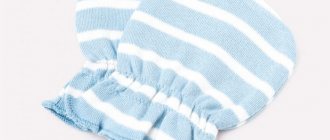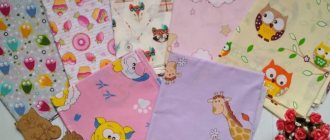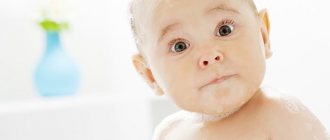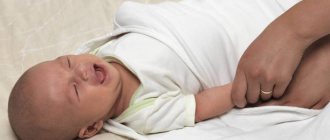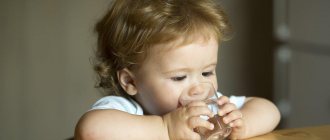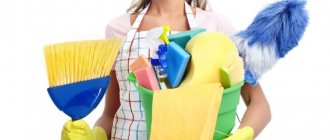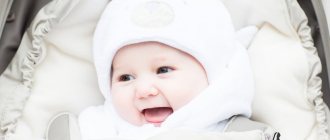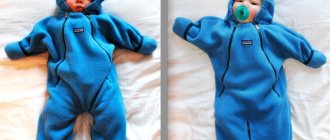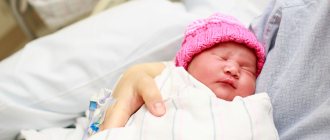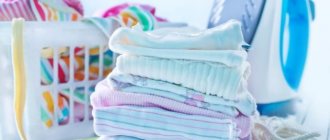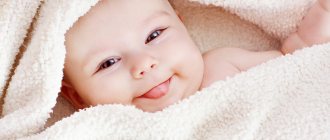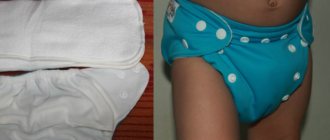Women who have become mothers for the first time, when discharged from the maternity hospital, often do not know whether they need to wear a cap for their newborn at home.
This is understandable, because in infants such a physiological process as thermoregulation is not yet developed at the proper level.
Thermoregulation of a newborn means appropriate clothing and the correct air temperature in the apartment.
Is the baby cold or hot?
An inexperienced mother should know the basic rules for determining temperature for a small family member:
- You should never rely on a thermometer that shows the temperature of a room or street, and even more so, on your own sensations and well-being.
- What needs to be taken into account is not the condition of the baby’s fingertips or nose, but the area of the feet, upper back, folds of the neck and crown.
- The main indicator is humidity (the child is hot and sweating) or, conversely, the coolness of certain parts of the body (the baby is cold). If in the first case it is necessary to change the baby into lighter clothes, then in the second, of course, you need to dress the baby warmer.
The best room temperature for a baby is 25-27 degrees Celsius.
How to properly dress a newborn?
A newly born baby should be dressed exclusively in natural materials, which include mainly “breathable” cotton and flannel fabrics, as well as lightweight knitwear.
Synthetics are strictly contraindicated: in the summer the baby sweats, and in the winter he freezes!
At home, one or two vests, rompers or light overalls are enough. If your baby's arms and legs are cold, he should wear sleeves and socks.
As for a hat, cap or scarf on a newborn’s head, there is no clear answer to this question either among “experienced” mothers and grandmothers, or experienced pediatricians.
There are two completely opposite opinions: some assert with complete confidence that a cap at home is mandatory even in hot weather, others believe that a cap should be worn depending on the situation - when going out onto the balcony or, in extreme cases, after taking a bath, and then only for 20-30 minutes, until your head dries out.
The baby’s weight is the main parameter that the mother monitors. What determines the weight of a child at birth and how a child should gain weight - read carefully.
Crafts from colored paper for children - see what you can make here.
We will tell you in this article how to teach a child to read at five years old and what methods to use.
Types of caps for newborns
Hats for babies should be soft, light colors, made of natural fabrics, preferably cotton. In such hats, children do not get hot or cold, they do not sweat, and the delicate skin of the back of the head does not become irritated or subject to diaper rash.
Modern stores offer a huge variety of caps for newborns, differing in color, shape and design.
Smart cap
When choosing hats for babies, you need to take into account the following features:
- the cap should be soft, hygroscopic, allow air to pass through well, not tightly fit the baby’s head and at the same time not bunch up;
- when purchasing caps, you should focus not so much on the age parameters indicated by the manufacturer on the label, but on the size of the head of the newborn itself;
- It is advisable to avoid bright hats, with various pictures or ornaments, since fabrics with pictures can cause allergies in the baby.
The best choice is a plain cotton cap with wide and soft ribbons.
Arguments for the cap
It is believed that the body of a newly born baby is still disproportionate, and the head is larger than the rest of the body.
For this reason, a newborn needs a light hat at any time of the year to protect him from possible drafts, temperature changes between rooms within the same apartment, and also to cover the baby’s still fragile fontanel.
Hats for a newborn should be light in the summer and moderately warm in the autumn-winter months and in no case contain buttons, snaps, tight laces and other various accessories, as well as hard and rough seams.
Mothers who advocate wearing a hat at home at any time of the day should be very careful, since the cap, as a result of involuntary movements of the head, can fall to the side or cover the baby’s face, which will lead to a lack of oxygen and difficulty breathing.
Why do newborns need a cap? How to choose?
Caps for newborns, as well as diapers and baby vests, are an obligatory and integral part of a baby's trousseau. In this case, weather conditions do not matter.
The main function of caps for newborns is to protect the baby’s head from adverse environmental influences. It must be taken into account that the air temperature, which is normal and comfortable for the parents of the baby, may not be suitable for the newborn at all. This is due to the inability of the body of a recently born child to regulate and retain its own heat.
In addition, there are fontanelles on the little man’s skull. Their hypothermia leads to negative consequences for the child’s health. Therefore, using a cap is acceptable not only before a walk, but also when ventilating the room and after water procedures.
In most cases, expectant mothers buy the clothes necessary for their newborn several months before giving birth. Nowadays, stores offer a wide range of children's caps. Despite this, the approach to their selection should be very careful and serious.
Naturally, when purchasing things, the first thing that catches your eye is the appearance of the product. But it is necessary to remember about the quality of the material that is used to sew clothes for babies. The baby's skin is delicate, so caps for newborns should be made of thin knitwear or cotton material. Under no circumstances should you purchase products that are characterized by unstable coloring.
Expectant mothers should take note that by the time the baby is born, there should be 2-3 caps in his wardrobe. Depending on what time of year it is, cambric with embroidery, knitted or knitted caps for newborns are purchased. To make a warm hat, both wool and other natural materials with the addition of synthetics can be used.
In some cases, prickly heat and various allergies appear on the baby’s skin. To prevent the occurrence of these unpleasant conditions, a knitted cap for the baby should be worn over a thin cap made of cotton material.
Please note that caps for newborns do not have to be purchased in stores. You can sew them yourself at home. Nowadays, there is a large amount of literature on this topic. In addition, a lot can be seen on the Internet. It should also be remembered that creating a pattern for a cap for a newborn does not require special skills and abilities, if only you had the desire.
Arguments against the bonnet
Firstly , only a born person has practically the same rights as other family members. If a healthy adult would never think of wearing a hat at home, then for what reason does a newborn need to cover his head?
Knitted cap
Secondly , the less you wrap a child, the healthier he will grow. Inside the rooms, the air temperature is never changeable, and the cap, in turn, fitting tightly to the head, creates a kind of greenhouse effect, causing only harm to the newborn baby and preventing the baby’s delicate skin from breathing.
Whatever the parents’ decision on the issue of whether to put on a newborn cap (cap, scarf), you should always remember the advice of the famous pediatrician Komarovsky that the baby’s skin should breathe.
Advantages and disadvantages of putting a cap on a newborn at home
Constantly wearing a headdress can lead to the following negative consequences:
- a sweat patch appears on the lower part of the back of the head;
- excessive wrapping leads to a natural result - frequent colds, you just need to blow a little breeze;
- the complete lack of hardening of the child is a counterbalance to a healthy lifestyle.
A newborn's constantly exposed head can cause:
- diseases of the middle ear or the development of meningitis;
- bending of one of the ears, since the baby may involuntarily lie on the ear during sleep.
All mothers panic if they notice their child is underweight. Indeed, this should be taken seriously, because sometimes lack of weight indicates internal pathologies.
Crisis of 3 years - what does it mean? You will find the opinions of psychologists in this topic.
What happens in practice?
Most young mothers start from a specific situation and adapt to the circumstances: they put on a cap after bathing, ventilating the children's room, when the heating is turned off, and also if the room temperature drops below 20 degrees Celsius, etc.
There are no compromises in the issue of putting caps on the head of a newborn: the older generation - grandmothers and mothers-in-law - are ardent supporters of wearing a cap at home up to one year old, modern pediatricians and new mothers believe that overheating is much dangerous for the baby’s health.
The newborn should have the same number of layers of clothing as the mother + one more.
How to dress a child at home?
Before deciding how to dress a newborn baby at home, you need to decide on the material from which the clothes are made. The fabric should be natural and soft, and the colors should be calm.
It is better if the seams are on the outside so that they cannot damage the baby’s delicate skin. Nothing should rub: no zippers, no fasteners.
Of course, you can’t do without them, but let them be on hangers. It’s better if they have buttons: they’re easy to fasten and unfasten. They save time changing clothes.
Which newborns need bonnets?
Firstly, light hats are required for weakened and premature babies, as well as children with colds.
Secondly, there is a category of babies who like to wear a hat; they become less capricious and quickly calm down when putting on a light headdress.
Thirdly, after bathing, newborns born with hair on their heads are usually put on either a cap, or most often a corner towel with a hood, so that the hairs dry quickly and the child does not catch a cold.
To summarize, in the matter of putting on a cap for a newborn, a mother should proceed from the general well-being of the baby and the factors surrounding him, since there are still no absolutely precise and one hundred percent rules by adhering to which one can prevent all childhood diseases that are characteristic of babies at the growing stage.
Why do children wear a cap at home?
With the need for a cap for a baby when going outside, everything is clear. Why do children wear caps at home? Most people know that since ancient times they tried to protect children as much as possible from external influences, so they were wrapped up tightly and put on warm caps. And now bonnets are actively worn at home. Moreover, they are often asked to take them with them immediately to the maternity hospital to be put on immediately after the birth of the baby.
The fact is that babies have especially delicate skin, and there is practically no hair on their heads. Do not forget about the unformed thermoregulation system of newborn babies. All this explains why children wear a cap indoors.
True, modern pediatricians are increasingly coming to the conclusion that when the room temperature is above +18 degrees, there is no need to wear a cap. After all, overheating is also dangerous for children's health.
All the advice given above about why children should wear a cap applies only to healthy children. If we are talking about weakened or premature babies, as well as those who are sick, then you should not neglect wearing a cap. This item is also necessary if the house is cold enough or there is a draft. In addition, the cap will be relevant immediately after swimming.
Women who have become mothers for the first time, when discharged from the maternity hospital, often do not know whether they need to wear a cap for their newborn at home.
This is understandable, because in infants such a physiological process as thermoregulation is not yet developed at the proper level.
Thermoregulation of a newborn means appropriate clothing and the correct air temperature in the apartment.
